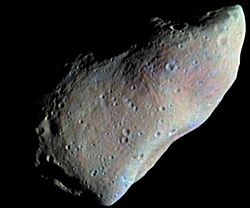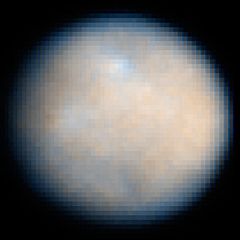Asteroid Belt

The asteroid belt is the region of the Solar System located roughly between the orbits of the planetsMars and Jupiter. It is occupied by numerous irregularly shaped bodies called asteroids or minor planets. The asteroid belt region is also termed the main belt to distinguish it from other concentrations of minor planets within the Solar System, such as the Kuiper belt and scattered disk.
More than half the mass within the main belt is contained in the four largest objects: Ceres, 4 Vesta, 2 Pallas, and 10 Hygiea. All of these have mean diameters of more than 400 km, while Ceres, the main belt's only dwarf planet, is about 950 km in diameter.[1][2][3][4] The remaining bodies range down to the size of a dust particle. The asteroid material is so thinly distributed that multiple unmanned spacecraft have traversed it without incident. Nonetheless, collisions between large asteroids do occur, and these can form an asteroid family whose members have similar orbital characteristics and compositions. Collisions also produce a fine dust that forms a major component of the zodiacal light. Individual asteroids within the main belt are categorized by their spectra, with most falling into three basic groups: carbonaceous (C-type), silicate (S-type), and metal-rich (M-type).
The asteroid belt formed from the primordial solar nebula as a group of planetesimals, the smaller precursors of the planets. Between Mars and Jupiter, however, gravitational perturbations from the giant planet imbued the planetesimals with too much orbital energy for them to accrete into a planet. Collisions became too violent, and instead of sticking together, the planetesimals shattered. As a result, most of the main belt's mass has been lost since the formation of the Solar System. Some fragments can eventually find their way into the inner Solar System, leading to meteorite impacts with the inner planets. Asteroid orbits continue to be appreciably perturbed whenever their period of revolution about the Sun forms an orbital resonance with Jupiter. At these orbital distances, a Kirkwood gap occurs as they are swept into other orbits.
Ceres

Ceres (pronounced /ˈsɪəriːz/,[14] or as Latin: Cerēs), also designated 1 Ceres (see minor planet names), is the smallest identified dwarf planet in the Solar System and the only one in the asteroid belt. It was discovered on January 1, 1801, by Giuseppe Piazzi,[15] and is named after the Roman goddessCeres—the goddess of growing plants, the harvest, and of motherly love.
With a diameter of about 950 km, Ceres is by far the largest and most massive body in the asteroid belt, and contains approximately a third of the belt's total mass.[16] Recent observations have revealed that it is spherical, unlike the irregular shapes of smaller bodies with lower gravity.[8] The surface of Ceres is probably made of a mixture of water ice and various hydratedminerals like carbonates and clays.[9] Ceres appears to be differentiated into a rockycore and ice mantle.[3] It may harbour an ocean of liquid water, which makes it a target of current searches for extraterrestrial life.[16] Ceres may be surrounded by a tenuous atmosphere containing water vapour.[17]
Ceres' apparent magnitude ranges from 6.7 to 9.3, hence at its brightest is still too dim to be seen with the naked eye.[10] On September 27, 2007, NASA launched the Dawn Mission space probe to explore Vesta (2011–2012) and Ceres (2015).[18]
